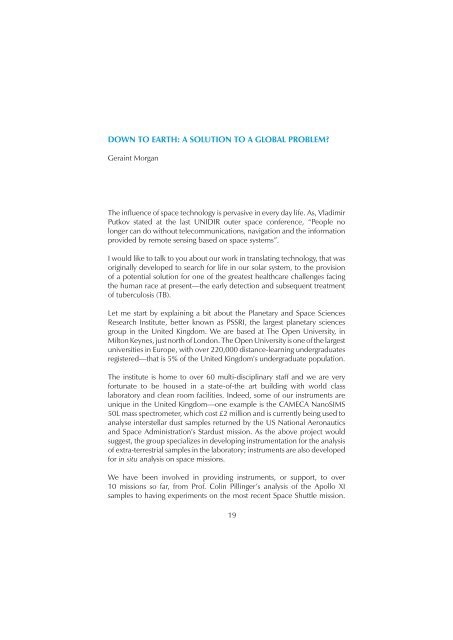Security in Space The Next Generation - UNIDIR
Security in Space The Next Generation - UNIDIR
Security in Space The Next Generation - UNIDIR
Create successful ePaper yourself
Turn your PDF publications into a flip-book with our unique Google optimized e-Paper software.
DOWN TO EARTH: A SOLUTION TO A GLOBAL PROBLEM?<br />
Gera<strong>in</strong>t Morgan<br />
<strong>The</strong> <strong>in</strong>fl uence of space technology is pervasive <strong>in</strong> every day life. As, Vladimir<br />
Putkov stated at the last <strong>UNIDIR</strong> outer space conference, “People no<br />
longer can do without telecommunications, navigation and the <strong>in</strong>formation<br />
provided by remote sens<strong>in</strong>g based on space systems”.<br />
I would like to talk to you about our work <strong>in</strong> translat<strong>in</strong>g technology, that was<br />
orig<strong>in</strong>ally developed to search for life <strong>in</strong> our solar system, to the provision<br />
of a potential solution for one of the greatest healthcare challenges fac<strong>in</strong>g<br />
the human race at present—the early detection and subsequent treatment<br />
of tuberculosis (TB).<br />
Let me start by expla<strong>in</strong><strong>in</strong>g a bit about the Planetary and <strong>Space</strong> Sciences<br />
Research Institute, better known as PSSRI, the largest planetary sciences<br />
group <strong>in</strong> the United K<strong>in</strong>gdom. We are based at <strong>The</strong> Open University, <strong>in</strong><br />
Milton Keynes, just north of London. <strong>The</strong> Open University is one of the largest<br />
universities <strong>in</strong> Europe, with over 220,000 distance-learn<strong>in</strong>g undergraduates<br />
registered—that is 5% of the United K<strong>in</strong>gdom’s undergraduate population.<br />
<strong>The</strong> <strong>in</strong>stitute is home to over 60 multi-discipl<strong>in</strong>ary staff and we are very<br />
fortunate to be housed <strong>in</strong> a state-of-the art build<strong>in</strong>g with world class<br />
laboratory and clean room facilities. Indeed, some of our <strong>in</strong>struments are<br />
unique <strong>in</strong> the United K<strong>in</strong>gdom—one example is the CAMECA NanoSIMS<br />
50L mass spectrometer, which cost £2 million and is currently be<strong>in</strong>g used to<br />
analyse <strong>in</strong>terstellar dust samples returned by the US National Aeronautics<br />
and <strong>Space</strong> Adm<strong>in</strong>istration’s Stardust mission. As the above project would<br />
suggest, the group specializes <strong>in</strong> develop<strong>in</strong>g <strong>in</strong>strumentation for the analysis<br />
of extra-terrestrial samples <strong>in</strong> the laboratory; <strong>in</strong>struments are also developed<br />
for <strong>in</strong> situ analysis on space missions.<br />
We have been <strong>in</strong>volved <strong>in</strong> provid<strong>in</strong>g <strong>in</strong>struments, or support, to over<br />
10 missions so far, from Prof. Col<strong>in</strong> Pill<strong>in</strong>ger’s analysis of the Apollo XI<br />
samples to hav<strong>in</strong>g experiments on the most recent <strong>Space</strong> Shuttle mission.<br />
19








